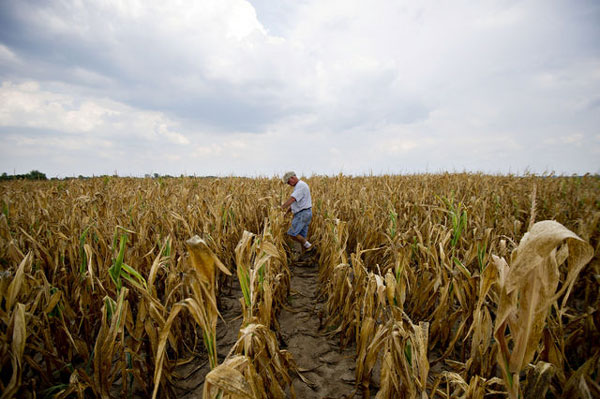America: The most serious drought in nearly 60 years
Lakes of ponds, rivers, underground wells, cattle-raising tanks in the states of Missouri and Arkansas are almost exhausted.
Corn and soybean fields in Illinois and Iowa states are burned. Even the second-longest river in the Mississippi world dropped to a rare low. It is the scene of the most severe drought in nearly 60 years that has been raging throughout the territory, especially the states that are stuck in the US.
The July 16 announcement of the US National Weather Data Center (NCDC) said about 71% of the US mainland territory had to see drought in June, of which 55% were drought. serious and 33% severely drought. This is the first time since December 1956, a large-scale drought occurred in the US territory.

The corn fields in Illinois were burned
June is also considered to be the third month of dry and hot weather in the United States for at least 118 years.
The Illinois governor, Pat Quinn, on July 16 added seven districts to the list of 26 districts that have been subjected to "natural disasters" , allowing farm owners access to the relief resources. the federal government.
Don Hudson, a farmer from Arkansas, said 83 years ago he had never witnessed the drought so much that 'grass cannot grow' like this year.
The most severely affected states of drought are the plains in the central and southern regions, especially in the Ohio valley.
According to the US Department of Agriculture's assessment, this year's heat and drought has affected 38%, many areas up to 50%, corn and soybean fields in 18 US agricultural states. The quality of corn and soybeans is also reduced due to extreme weather. Farmers in some places had to sell their cattle quickly because of lack of grass and drinking water.
The drought last year alone in the South and Southwest states of the United States caused about $ 12 billion in damage. The drought situation this year has been so serious that 26 states have declared a disaster.
Last June was identified as the fourth highest month of global warming since 1880, marking the 328th consecutive month of global temperature above the average temperature of the 20th century.
- More than half of America has suffered from drought
- Drought lasts for centuries in North America
- Drought in Spain in the past 500 years
- Natural disasters: cold in Europe and America, drought in China
- Brazil: The most severe drought in the past half century
- Drought in Spain is the most serious in 150 years
- 10 million Africans are at risk of drought
- Drought can change the history of humanity
- Drought in the Amazon forest causes climate change
- The town sinks 'floating' again after 25 years
- The most serious disaster in 100 years is raging in the West
- Human anti-drought weapons are here
 Is the magnetic North Pole shift dangerous to humanity?
Is the magnetic North Pole shift dangerous to humanity? Washington legalizes the recycling of human bodies into fertilizer
Washington legalizes the recycling of human bodies into fertilizer Lightning stone - the mysterious guest
Lightning stone - the mysterious guest Stunned by the mysterious sunset, strange appearance
Stunned by the mysterious sunset, strange appearance